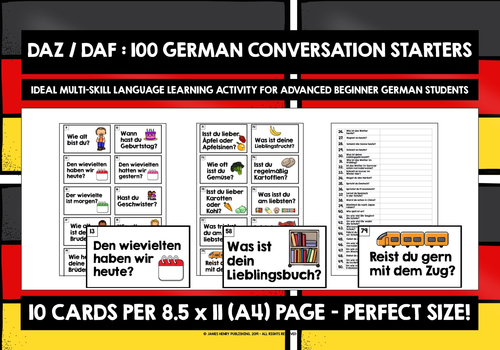





DAZ DAF ADVANCED BEGINNER GERMAN INTERMEDIATE GERMAN CONVERSATION STARTERS
Files are non-editable in a zipped format. The resource is copyright, all rights reserved. It may not be copied, rewritten, amended, shared or distributed outside your own classroom in any way. The license for purchase is a single-user license only. Please read the Terms of Use.
This set of German conversation starters features 100 starters in question format, suitable for advanced beginner German into intermediate German students. Speaking is a language skill that learners tend to find very challenging, and increased engagement with language that requires them to both reproduce language they are already familiar with, and to be creative with that language in order to produce new language is integral to successful language learning.
The questions focus largely on the present tense, with some examples of the past tenses. I include tenses we may not have formally covered, as the activity is not solely about practicing language, but also about actively learning it. I encourage students to look for cues and clues in the questions themselves, and this certainly enables them to engage with new or unknown language successfully, and to progress in their learning.
Each card has an image: some of these are specific visual prompts to help students infer meaning; some are more generic images. I do use images as much as possible with this kind of activity, not only to provide the prompt, but also to add to the visual appeal of it, which is a real motivator for learning.
I remind students that it is not necessary to tell the truth - the purpose is to create and produce accurate and realistic language. Students can prepare their responses in as much detail as possible on the accompanying planning sheet, remembering that these are conversation starters, so that once they have responded, they should then say something to keep the conversation going.
As a whole-group activity, distribute the cards amongst your students, one or several. Ideally, they should walk around the classroom, asking questions, and swapping cards. For pair or small-group work, students can work in a designated area. This really helps them focus closely on the language, and helps learners who are slightly less confident working with a larger group.
The starters broadly address the following themes:
- personal information
- family & routines at home
- hobbies & free time
- likes & dislikes
- local environment
- food & drink
- school & studies
- sport & healthy living
- countries & languages
- weather & seasons
Have a browse in my store for more German independent learning activities, and a wide range of other German teaching and learning materials, with German dollar deals, special offer bundles, and lots of freebies.
VIELEN DANK UND VIEL SPAß IN DER DEUTSCHSTUNDE!
Something went wrong, please try again later.
This resource hasn't been reviewed yet
To ensure quality for our reviews, only customers who have purchased this resource can review it
Report this resourceto let us know if it violates our terms and conditions.
Our customer service team will review your report and will be in touch.